Toyota Marketing: Competitor Analysis, SWOT & Environmental Factors
VerifiedAdded on 2023/06/07
|8
|1691
|137
Report
AI Summary
This report provides a comprehensive analysis of Toyota's marketing environment, utilizing various frameworks and models. It begins with a PESTLE analysis, examining political, economic, social, technological, environmental, and legal factors impacting Toyota. The report then delves into micro-environmental factors using Porter's Five Forces, assessing the bargaining power of suppliers and customers, the threat of substitutes and new entrants, and competitive rivalry. A competitor analysis focuses on Honda and Ford, highlighting their competitive strategies. Finally, a SWOT analysis evaluates Toyota's strengths, weaknesses, opportunities, and threats. The report concludes by emphasizing the importance of strategic adaptation to maintain competitiveness in the automotive market. Desklib offers a range of similar reports and study tools for students.
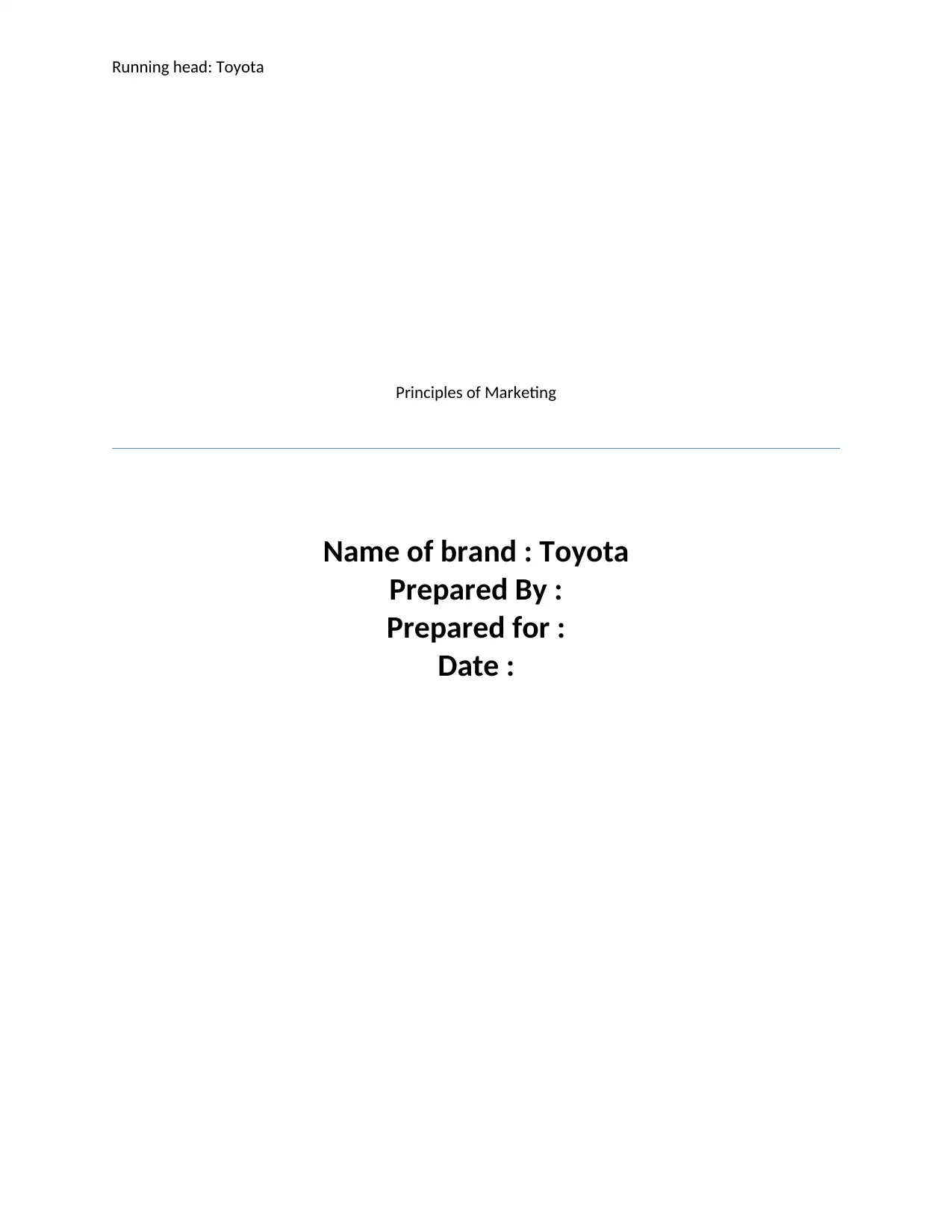
Running head: Toyota
Principles of Marketing
Name of brand : Toyota
Prepared By :
Prepared for :
Date :
Principles of Marketing
Name of brand : Toyota
Prepared By :
Prepared for :
Date :
Paraphrase This Document
Need a fresh take? Get an instant paraphrase of this document with our AI Paraphraser
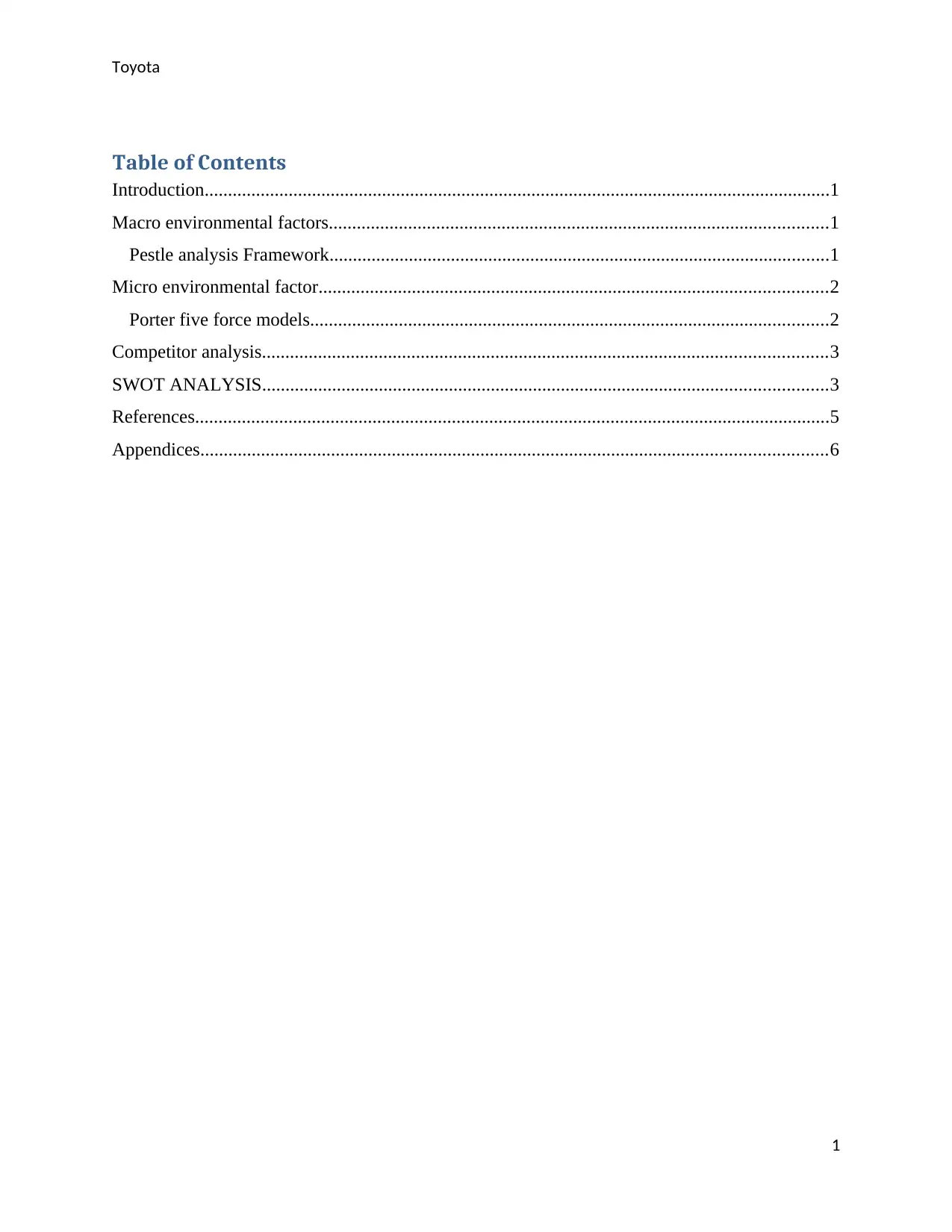
Toyota
Table of Contents
Introduction......................................................................................................................................1
Macro environmental factors...........................................................................................................1
Pestle analysis Framework...........................................................................................................1
Micro environmental factor.............................................................................................................2
Porter five force models...............................................................................................................2
Competitor analysis.........................................................................................................................3
SWOT ANALYSIS.........................................................................................................................3
References........................................................................................................................................5
Appendices......................................................................................................................................6
1
Table of Contents
Introduction......................................................................................................................................1
Macro environmental factors...........................................................................................................1
Pestle analysis Framework...........................................................................................................1
Micro environmental factor.............................................................................................................2
Porter five force models...............................................................................................................2
Competitor analysis.........................................................................................................................3
SWOT ANALYSIS.........................................................................................................................3
References........................................................................................................................................5
Appendices......................................................................................................................................6
1
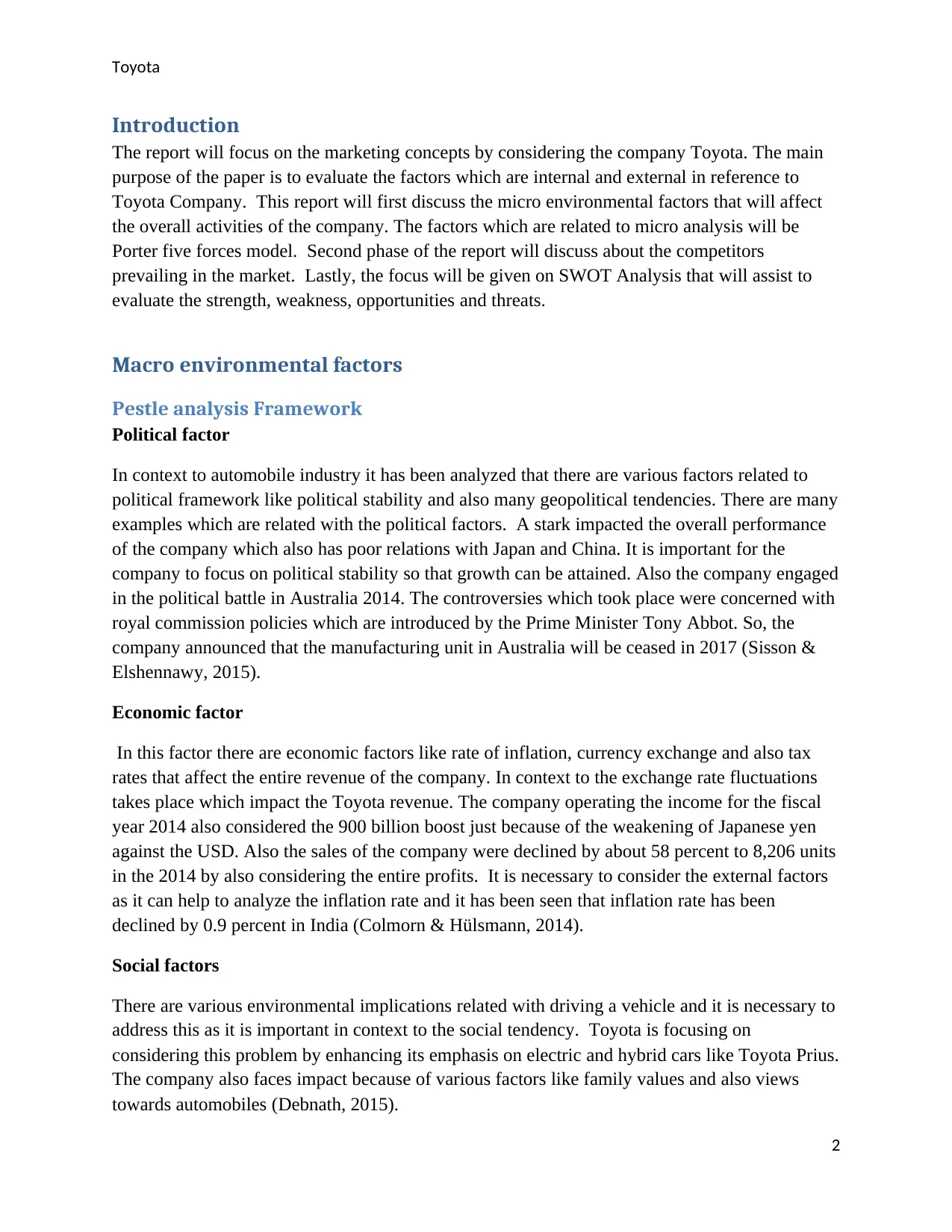
Toyota
Introduction
The report will focus on the marketing concepts by considering the company Toyota. The main
purpose of the paper is to evaluate the factors which are internal and external in reference to
Toyota Company. This report will first discuss the micro environmental factors that will affect
the overall activities of the company. The factors which are related to micro analysis will be
Porter five forces model. Second phase of the report will discuss about the competitors
prevailing in the market. Lastly, the focus will be given on SWOT Analysis that will assist to
evaluate the strength, weakness, opportunities and threats.
Macro environmental factors
Pestle analysis Framework
Political factor
In context to automobile industry it has been analyzed that there are various factors related to
political framework like political stability and also many geopolitical tendencies. There are many
examples which are related with the political factors. A stark impacted the overall performance
of the company which also has poor relations with Japan and China. It is important for the
company to focus on political stability so that growth can be attained. Also the company engaged
in the political battle in Australia 2014. The controversies which took place were concerned with
royal commission policies which are introduced by the Prime Minister Tony Abbot. So, the
company announced that the manufacturing unit in Australia will be ceased in 2017 (Sisson &
Elshennawy, 2015).
Economic factor
In this factor there are economic factors like rate of inflation, currency exchange and also tax
rates that affect the entire revenue of the company. In context to the exchange rate fluctuations
takes place which impact the Toyota revenue. The company operating the income for the fiscal
year 2014 also considered the 900 billion boost just because of the weakening of Japanese yen
against the USD. Also the sales of the company were declined by about 58 percent to 8,206 units
in the 2014 by also considering the entire profits. It is necessary to consider the external factors
as it can help to analyze the inflation rate and it has been seen that inflation rate has been
declined by 0.9 percent in India (Colmorn & Hülsmann, 2014).
Social factors
There are various environmental implications related with driving a vehicle and it is necessary to
address this as it is important in context to the social tendency. Toyota is focusing on
considering this problem by enhancing its emphasis on electric and hybrid cars like Toyota Prius.
The company also faces impact because of various factors like family values and also views
towards automobiles (Debnath, 2015).
2
Introduction
The report will focus on the marketing concepts by considering the company Toyota. The main
purpose of the paper is to evaluate the factors which are internal and external in reference to
Toyota Company. This report will first discuss the micro environmental factors that will affect
the overall activities of the company. The factors which are related to micro analysis will be
Porter five forces model. Second phase of the report will discuss about the competitors
prevailing in the market. Lastly, the focus will be given on SWOT Analysis that will assist to
evaluate the strength, weakness, opportunities and threats.
Macro environmental factors
Pestle analysis Framework
Political factor
In context to automobile industry it has been analyzed that there are various factors related to
political framework like political stability and also many geopolitical tendencies. There are many
examples which are related with the political factors. A stark impacted the overall performance
of the company which also has poor relations with Japan and China. It is important for the
company to focus on political stability so that growth can be attained. Also the company engaged
in the political battle in Australia 2014. The controversies which took place were concerned with
royal commission policies which are introduced by the Prime Minister Tony Abbot. So, the
company announced that the manufacturing unit in Australia will be ceased in 2017 (Sisson &
Elshennawy, 2015).
Economic factor
In this factor there are economic factors like rate of inflation, currency exchange and also tax
rates that affect the entire revenue of the company. In context to the exchange rate fluctuations
takes place which impact the Toyota revenue. The company operating the income for the fiscal
year 2014 also considered the 900 billion boost just because of the weakening of Japanese yen
against the USD. Also the sales of the company were declined by about 58 percent to 8,206 units
in the 2014 by also considering the entire profits. It is necessary to consider the external factors
as it can help to analyze the inflation rate and it has been seen that inflation rate has been
declined by 0.9 percent in India (Colmorn & Hülsmann, 2014).
Social factors
There are various environmental implications related with driving a vehicle and it is necessary to
address this as it is important in context to the social tendency. Toyota is focusing on
considering this problem by enhancing its emphasis on electric and hybrid cars like Toyota Prius.
The company also faces impact because of various factors like family values and also views
towards automobiles (Debnath, 2015).
2
⊘ This is a preview!⊘
Do you want full access?
Subscribe today to unlock all pages.

Trusted by 1+ million students worldwide
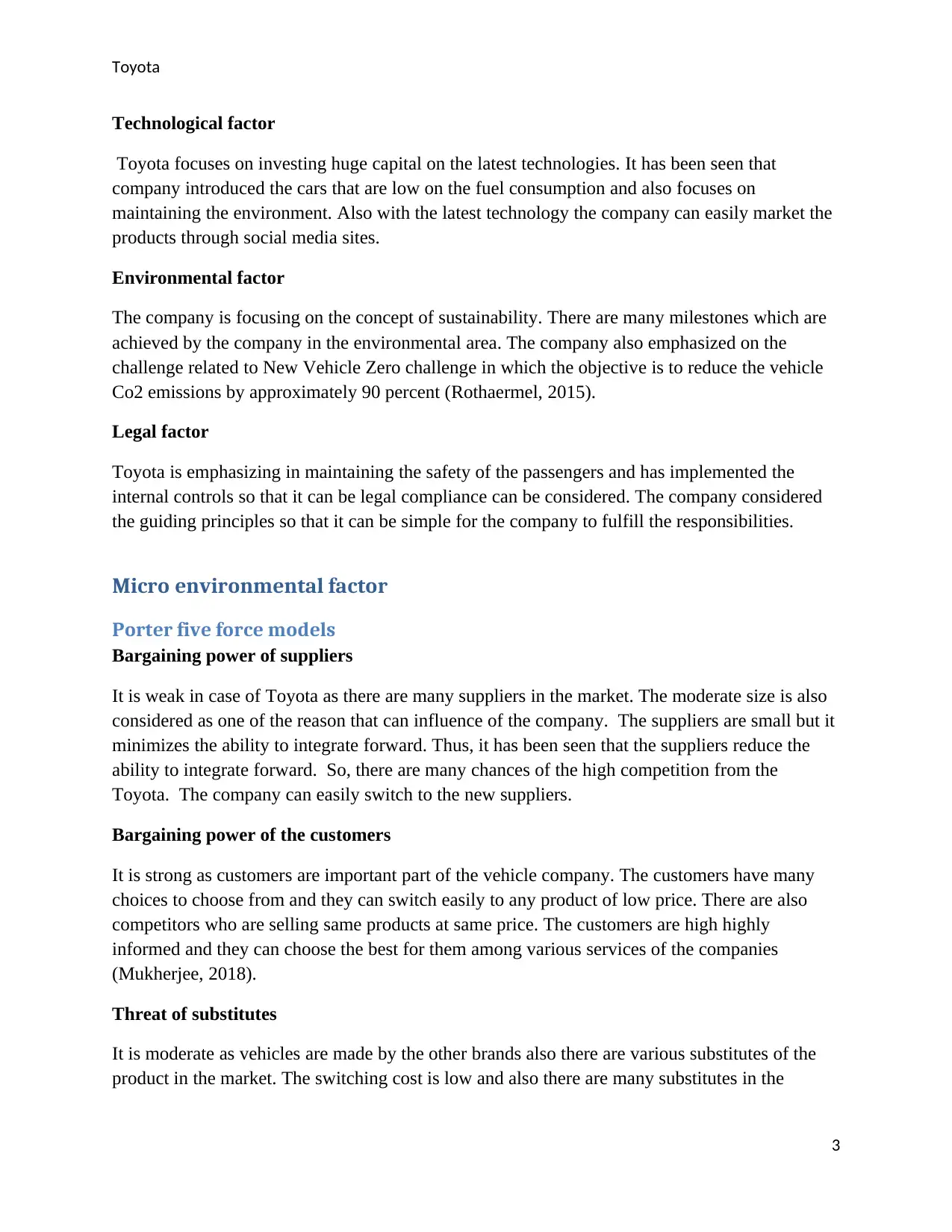
Toyota
Technological factor
Toyota focuses on investing huge capital on the latest technologies. It has been seen that
company introduced the cars that are low on the fuel consumption and also focuses on
maintaining the environment. Also with the latest technology the company can easily market the
products through social media sites.
Environmental factor
The company is focusing on the concept of sustainability. There are many milestones which are
achieved by the company in the environmental area. The company also emphasized on the
challenge related to New Vehicle Zero challenge in which the objective is to reduce the vehicle
Co2 emissions by approximately 90 percent (Rothaermel, 2015).
Legal factor
Toyota is emphasizing in maintaining the safety of the passengers and has implemented the
internal controls so that it can be legal compliance can be considered. The company considered
the guiding principles so that it can be simple for the company to fulfill the responsibilities.
Micro environmental factor
Porter five force models
Bargaining power of suppliers
It is weak in case of Toyota as there are many suppliers in the market. The moderate size is also
considered as one of the reason that can influence of the company. The suppliers are small but it
minimizes the ability to integrate forward. Thus, it has been seen that the suppliers reduce the
ability to integrate forward. So, there are many chances of the high competition from the
Toyota. The company can easily switch to the new suppliers.
Bargaining power of the customers
It is strong as customers are important part of the vehicle company. The customers have many
choices to choose from and they can switch easily to any product of low price. There are also
competitors who are selling same products at same price. The customers are high highly
informed and they can choose the best for them among various services of the companies
(Mukherjee, 2018).
Threat of substitutes
It is moderate as vehicles are made by the other brands also there are various substitutes of the
product in the market. The switching cost is low and also there are many substitutes in the
3
Technological factor
Toyota focuses on investing huge capital on the latest technologies. It has been seen that
company introduced the cars that are low on the fuel consumption and also focuses on
maintaining the environment. Also with the latest technology the company can easily market the
products through social media sites.
Environmental factor
The company is focusing on the concept of sustainability. There are many milestones which are
achieved by the company in the environmental area. The company also emphasized on the
challenge related to New Vehicle Zero challenge in which the objective is to reduce the vehicle
Co2 emissions by approximately 90 percent (Rothaermel, 2015).
Legal factor
Toyota is emphasizing in maintaining the safety of the passengers and has implemented the
internal controls so that it can be legal compliance can be considered. The company considered
the guiding principles so that it can be simple for the company to fulfill the responsibilities.
Micro environmental factor
Porter five force models
Bargaining power of suppliers
It is weak in case of Toyota as there are many suppliers in the market. The moderate size is also
considered as one of the reason that can influence of the company. The suppliers are small but it
minimizes the ability to integrate forward. Thus, it has been seen that the suppliers reduce the
ability to integrate forward. So, there are many chances of the high competition from the
Toyota. The company can easily switch to the new suppliers.
Bargaining power of the customers
It is strong as customers are important part of the vehicle company. The customers have many
choices to choose from and they can switch easily to any product of low price. There are also
competitors who are selling same products at same price. The customers are high highly
informed and they can choose the best for them among various services of the companies
(Mukherjee, 2018).
Threat of substitutes
It is moderate as vehicles are made by the other brands also there are various substitutes of the
product in the market. The switching cost is low and also there are many substitutes in the
3
Paraphrase This Document
Need a fresh take? Get an instant paraphrase of this document with our AI Paraphraser
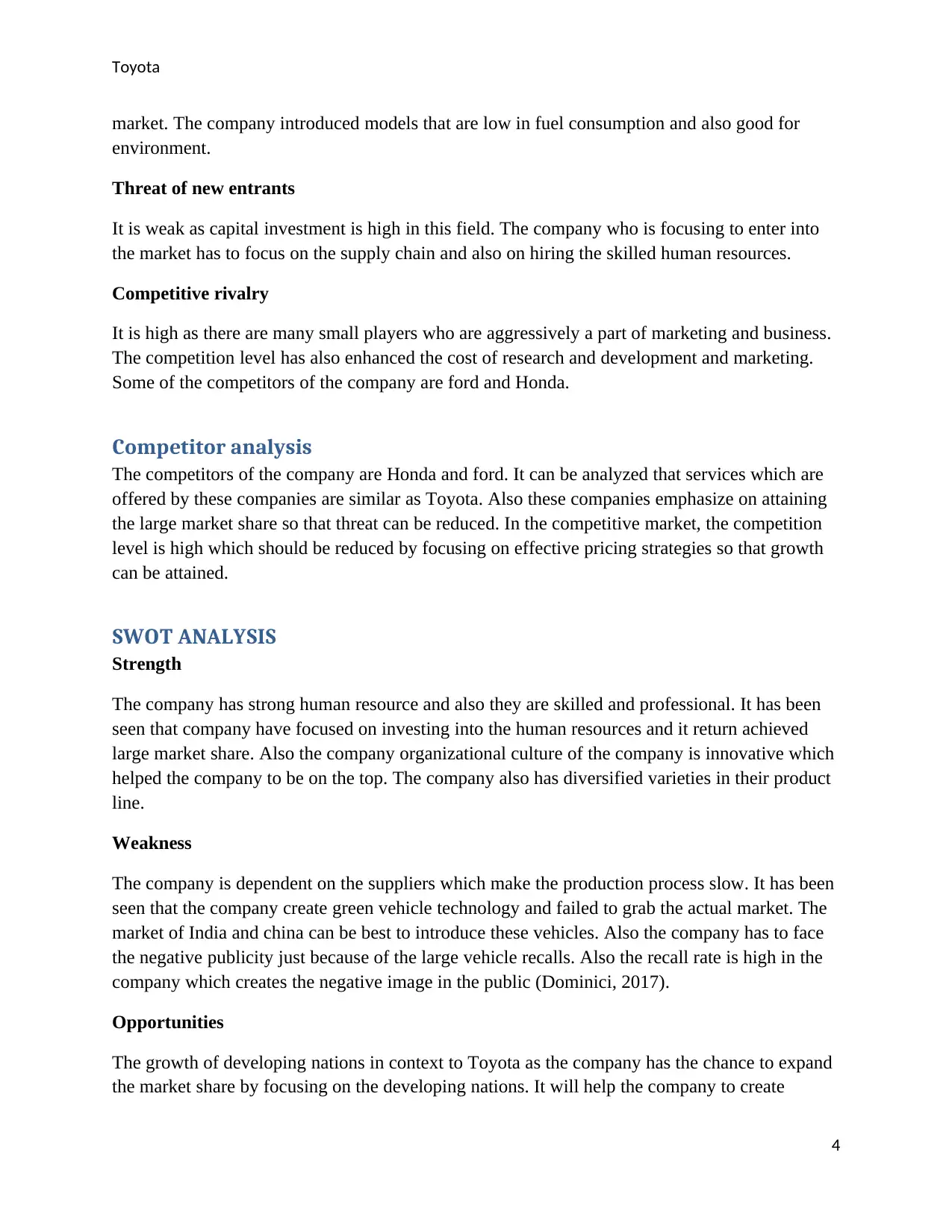
Toyota
market. The company introduced models that are low in fuel consumption and also good for
environment.
Threat of new entrants
It is weak as capital investment is high in this field. The company who is focusing to enter into
the market has to focus on the supply chain and also on hiring the skilled human resources.
Competitive rivalry
It is high as there are many small players who are aggressively a part of marketing and business.
The competition level has also enhanced the cost of research and development and marketing.
Some of the competitors of the company are ford and Honda.
Competitor analysis
The competitors of the company are Honda and ford. It can be analyzed that services which are
offered by these companies are similar as Toyota. Also these companies emphasize on attaining
the large market share so that threat can be reduced. In the competitive market, the competition
level is high which should be reduced by focusing on effective pricing strategies so that growth
can be attained.
SWOT ANALYSIS
Strength
The company has strong human resource and also they are skilled and professional. It has been
seen that company have focused on investing into the human resources and it return achieved
large market share. Also the company organizational culture of the company is innovative which
helped the company to be on the top. The company also has diversified varieties in their product
line.
Weakness
The company is dependent on the suppliers which make the production process slow. It has been
seen that the company create green vehicle technology and failed to grab the actual market. The
market of India and china can be best to introduce these vehicles. Also the company has to face
the negative publicity just because of the large vehicle recalls. Also the recall rate is high in the
company which creates the negative image in the public (Dominici, 2017).
Opportunities
The growth of developing nations in context to Toyota as the company has the chance to expand
the market share by focusing on the developing nations. It will help the company to create
4
market. The company introduced models that are low in fuel consumption and also good for
environment.
Threat of new entrants
It is weak as capital investment is high in this field. The company who is focusing to enter into
the market has to focus on the supply chain and also on hiring the skilled human resources.
Competitive rivalry
It is high as there are many small players who are aggressively a part of marketing and business.
The competition level has also enhanced the cost of research and development and marketing.
Some of the competitors of the company are ford and Honda.
Competitor analysis
The competitors of the company are Honda and ford. It can be analyzed that services which are
offered by these companies are similar as Toyota. Also these companies emphasize on attaining
the large market share so that threat can be reduced. In the competitive market, the competition
level is high which should be reduced by focusing on effective pricing strategies so that growth
can be attained.
SWOT ANALYSIS
Strength
The company has strong human resource and also they are skilled and professional. It has been
seen that company have focused on investing into the human resources and it return achieved
large market share. Also the company organizational culture of the company is innovative which
helped the company to be on the top. The company also has diversified varieties in their product
line.
Weakness
The company is dependent on the suppliers which make the production process slow. It has been
seen that the company create green vehicle technology and failed to grab the actual market. The
market of India and china can be best to introduce these vehicles. Also the company has to face
the negative publicity just because of the large vehicle recalls. Also the recall rate is high in the
company which creates the negative image in the public (Dominici, 2017).
Opportunities
The growth of developing nations in context to Toyota as the company has the chance to expand
the market share by focusing on the developing nations. It will help the company to create
4
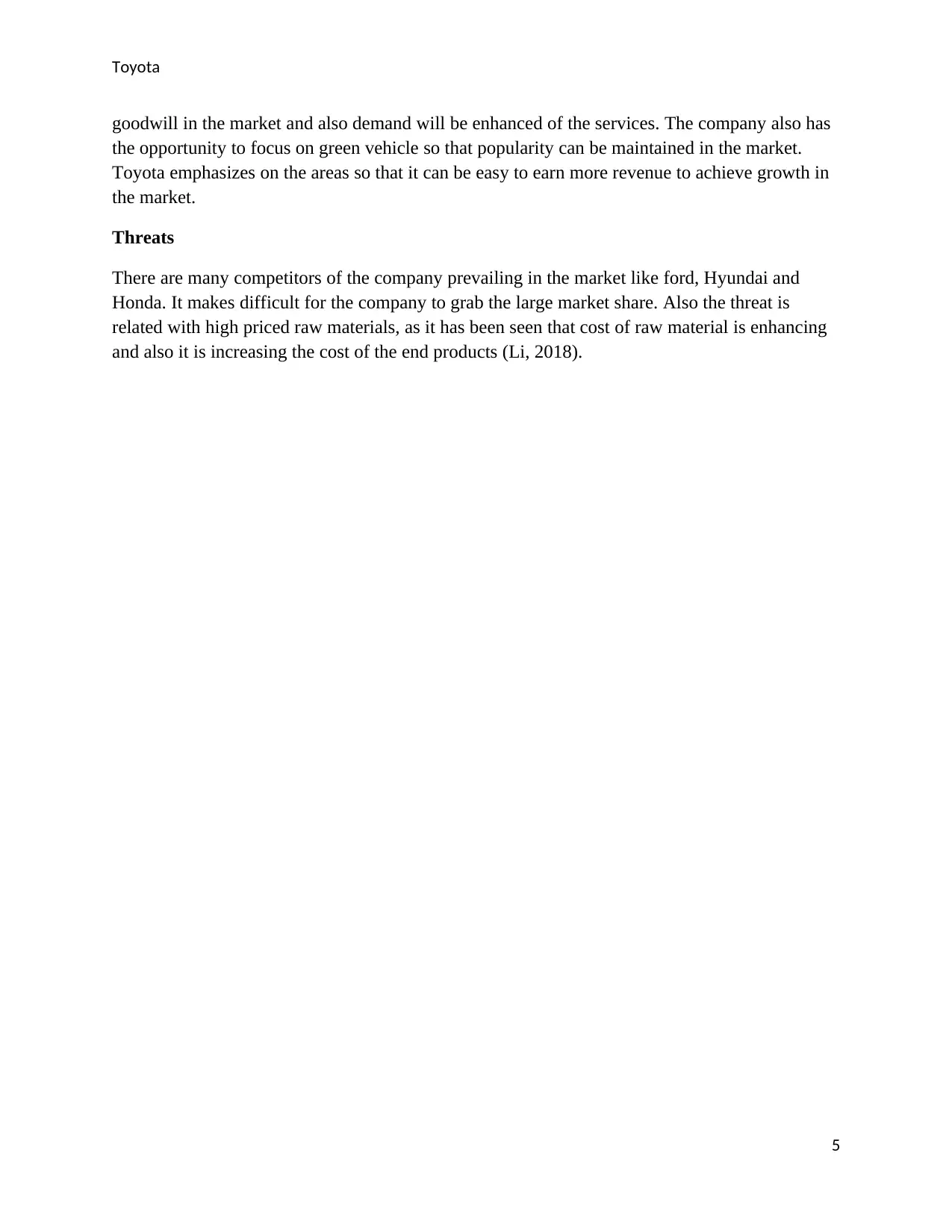
Toyota
goodwill in the market and also demand will be enhanced of the services. The company also has
the opportunity to focus on green vehicle so that popularity can be maintained in the market.
Toyota emphasizes on the areas so that it can be easy to earn more revenue to achieve growth in
the market.
Threats
There are many competitors of the company prevailing in the market like ford, Hyundai and
Honda. It makes difficult for the company to grab the large market share. Also the threat is
related with high priced raw materials, as it has been seen that cost of raw material is enhancing
and also it is increasing the cost of the end products (Li, 2018).
5
goodwill in the market and also demand will be enhanced of the services. The company also has
the opportunity to focus on green vehicle so that popularity can be maintained in the market.
Toyota emphasizes on the areas so that it can be easy to earn more revenue to achieve growth in
the market.
Threats
There are many competitors of the company prevailing in the market like ford, Hyundai and
Honda. It makes difficult for the company to grab the large market share. Also the threat is
related with high priced raw materials, as it has been seen that cost of raw material is enhancing
and also it is increasing the cost of the end products (Li, 2018).
5
⊘ This is a preview!⊘
Do you want full access?
Subscribe today to unlock all pages.

Trusted by 1+ million students worldwide
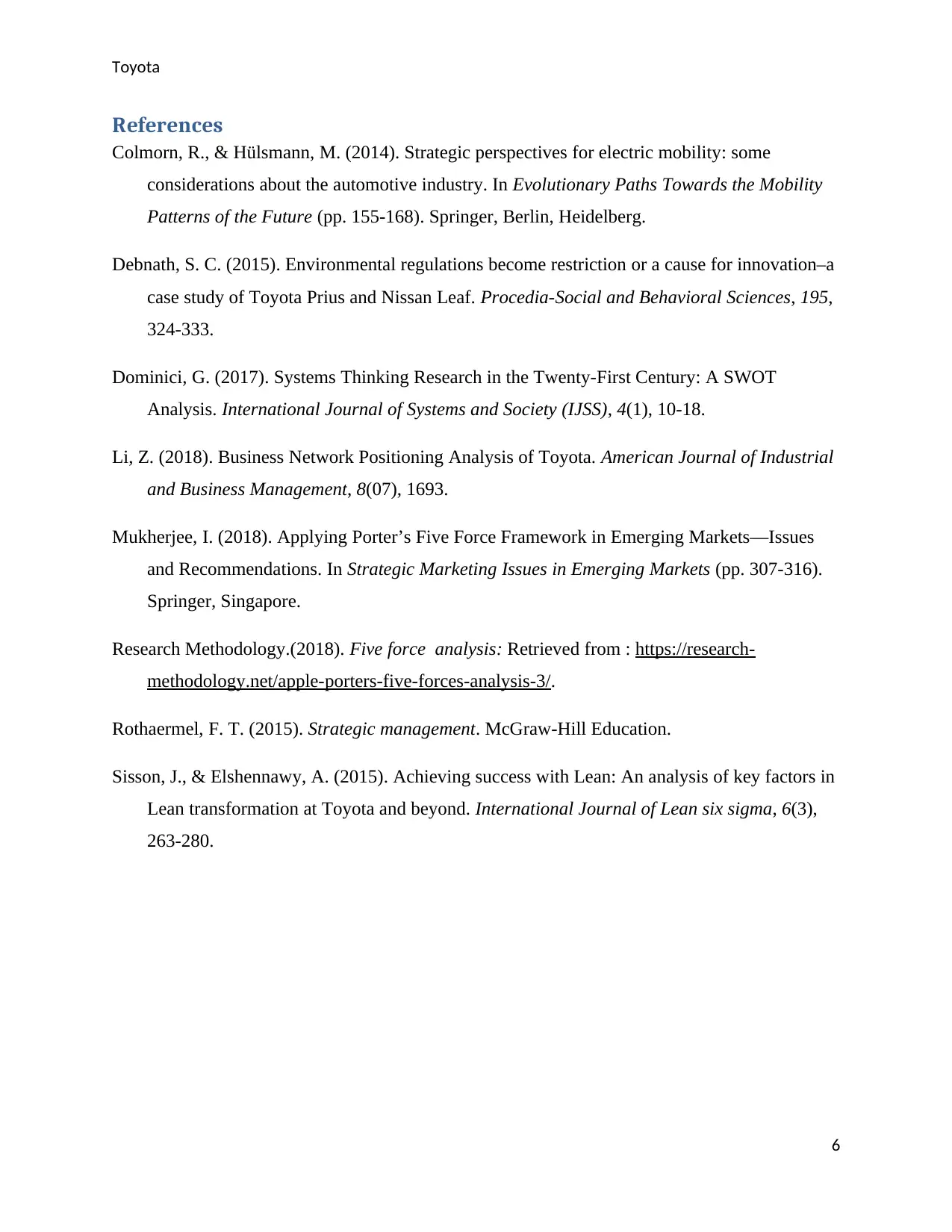
Toyota
References
Colmorn, R., & Hülsmann, M. (2014). Strategic perspectives for electric mobility: some
considerations about the automotive industry. In Evolutionary Paths Towards the Mobility
Patterns of the Future (pp. 155-168). Springer, Berlin, Heidelberg.
Debnath, S. C. (2015). Environmental regulations become restriction or a cause for innovation–a
case study of Toyota Prius and Nissan Leaf. Procedia-Social and Behavioral Sciences, 195,
324-333.
Dominici, G. (2017). Systems Thinking Research in the Twenty-First Century: A SWOT
Analysis. International Journal of Systems and Society (IJSS), 4(1), 10-18.
Li, Z. (2018). Business Network Positioning Analysis of Toyota. American Journal of Industrial
and Business Management, 8(07), 1693.
Mukherjee, I. (2018). Applying Porter’s Five Force Framework in Emerging Markets—Issues
and Recommendations. In Strategic Marketing Issues in Emerging Markets (pp. 307-316).
Springer, Singapore.
Research Methodology.(2018). Five force analysis: Retrieved from : https://research-
methodology.net/apple-porters-five-forces-analysis-3/.
Rothaermel, F. T. (2015). Strategic management. McGraw-Hill Education.
Sisson, J., & Elshennawy, A. (2015). Achieving success with Lean: An analysis of key factors in
Lean transformation at Toyota and beyond. International Journal of Lean six sigma, 6(3),
263-280.
6
References
Colmorn, R., & Hülsmann, M. (2014). Strategic perspectives for electric mobility: some
considerations about the automotive industry. In Evolutionary Paths Towards the Mobility
Patterns of the Future (pp. 155-168). Springer, Berlin, Heidelberg.
Debnath, S. C. (2015). Environmental regulations become restriction or a cause for innovation–a
case study of Toyota Prius and Nissan Leaf. Procedia-Social and Behavioral Sciences, 195,
324-333.
Dominici, G. (2017). Systems Thinking Research in the Twenty-First Century: A SWOT
Analysis. International Journal of Systems and Society (IJSS), 4(1), 10-18.
Li, Z. (2018). Business Network Positioning Analysis of Toyota. American Journal of Industrial
and Business Management, 8(07), 1693.
Mukherjee, I. (2018). Applying Porter’s Five Force Framework in Emerging Markets—Issues
and Recommendations. In Strategic Marketing Issues in Emerging Markets (pp. 307-316).
Springer, Singapore.
Research Methodology.(2018). Five force analysis: Retrieved from : https://research-
methodology.net/apple-porters-five-forces-analysis-3/.
Rothaermel, F. T. (2015). Strategic management. McGraw-Hill Education.
Sisson, J., & Elshennawy, A. (2015). Achieving success with Lean: An analysis of key factors in
Lean transformation at Toyota and beyond. International Journal of Lean six sigma, 6(3),
263-280.
6
Paraphrase This Document
Need a fresh take? Get an instant paraphrase of this document with our AI Paraphraser
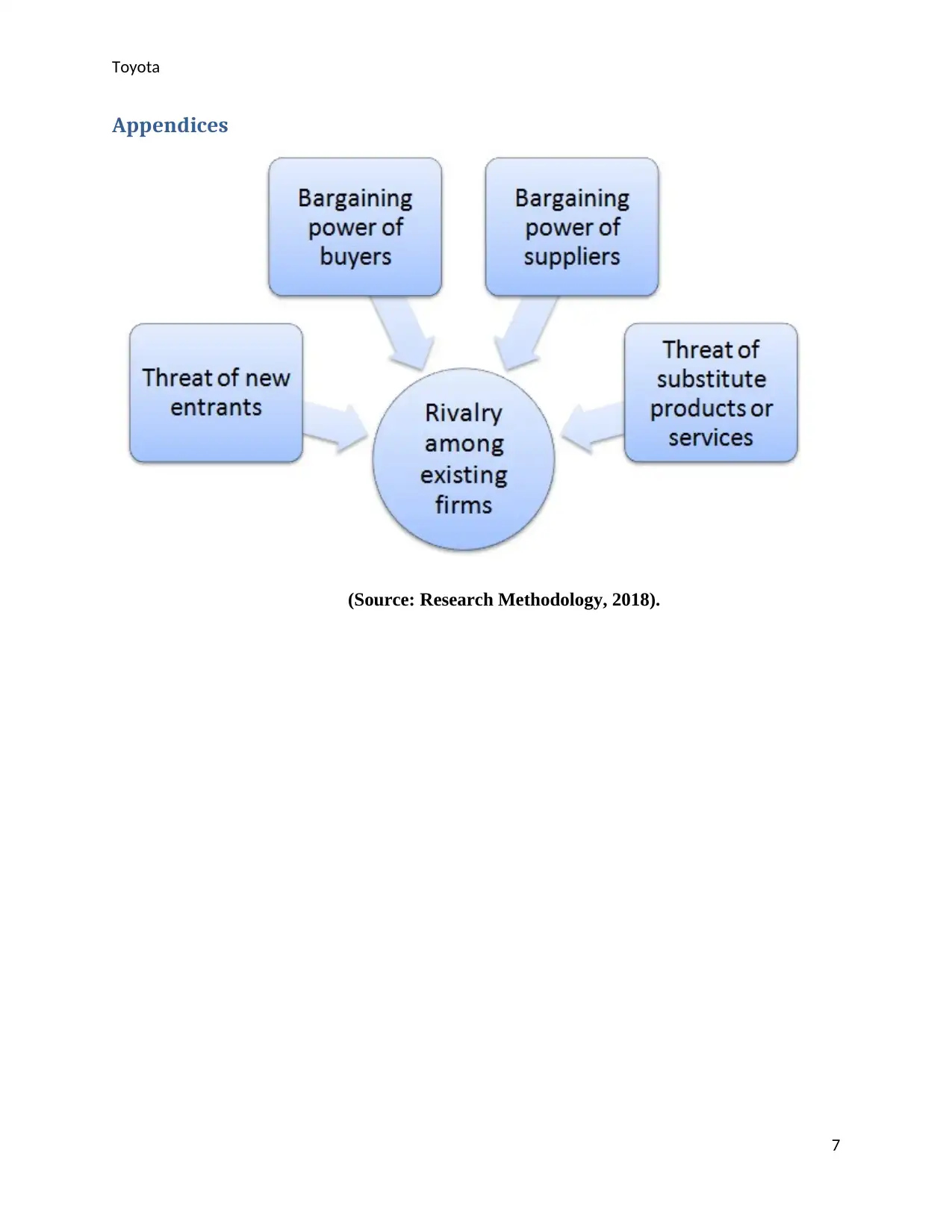
Toyota
Appendices
(Source: Research Methodology, 2018).
7
Appendices
(Source: Research Methodology, 2018).
7
1 out of 8
Related Documents
Your All-in-One AI-Powered Toolkit for Academic Success.
+13062052269
info@desklib.com
Available 24*7 on WhatsApp / Email
![[object Object]](/_next/static/media/star-bottom.7253800d.svg)
Unlock your academic potential
Copyright © 2020–2025 A2Z Services. All Rights Reserved. Developed and managed by ZUCOL.





